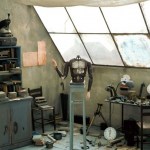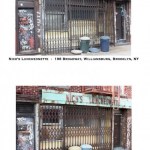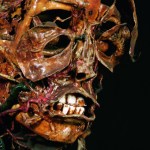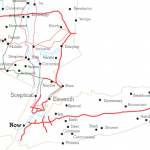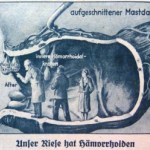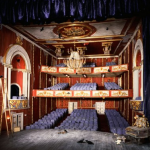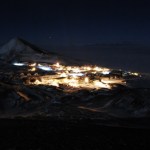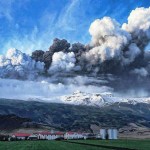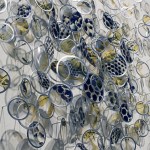Destinations
L'Automaton #06, 2010
Paolo Ventura
(zoom view available here)
Artist-photographer Paolo Ventura constructs and photographs miniature, dreamlike scenes. His Winter Stories represent the reminisces of an old circus performer. Above, a scene from the Automaton series captures a mysterious, half-built android. Who is the android's creator? When and where is this happening? Ventura's work is evocative precisely because it is so mysterious. (It turns out that Ventura's backstory for the Automaton series involves a lonely watchmaker in the Jewish ghetto of 1942 Venice - but still, that hardly…
Nick's Luncheonette
Randy Hage
Via the eye-candy blog How to Be a Retronaut (thanks Miles for first sending me a link there), the painstakingly accurate miniature Manhattan streetscapes of LA artist Randy Hage are half-toy, half-historical document - a wonder cabinet of urban curiosities.
Hage's overarching goal is to preserve rapidly disappearing streetscapes. As he told Jeremiah Moss at Vanishing New York,
I remember one instance in particular that prompted me to seriously focus on this project. I was on my way to revisit a Brooklyn donut shop that I had photographed a year earlier. I…
From the Smithsonian, a short video about using technology to virtually reassemble ancient art from fragments long carried away and dispersed:
Majestic sixth-century Chinese Buddhist sculpture is combined with 3-D imaging technology in this exploration of one of the most important groups of Buddhist devotional sites in early medieval China. Carved into the mountains of northern China, the Buddhist cave temples of Xiangtangshan were the crowning cultural achievement of the Northern Qi dynasty (550-77 CE). Once home to a magnificent array of sculptures--monumental Buddhas, divine attendant…
. . . they could have. Or pretty darn close, at least - they just needed to visit one of the many European cabinets of anatomical curiosities, to see the work of anatomists like Honore Fragonard.
Fragonard's eighteenth-century ecorches were the clear precursors to Gunther von Hagens' "Body Worlds" exhibits: preserved, injected, partially dissected bodies in lifelike, dramatic poses, with ragged strips of muscle draped like primitive clothing over exposed vessels and nerves. The effect is eerie - like a Vesalius illustration sprung to (half-)life:
Man with a Mandible
Several of Fragonard's…
Miracle of Science: the Cambridge bar around the corner from MIT, where the menu is a (pseudo) periodic table. May I recommend the grilled chicken salad with cilantro lime dressing, "Sc"?
Now this is just cruel: yesterday the Cambridge Science Festival kicked off - a week of science, sciart, sci-journalism and sci-education activities at MIT, Harvard, the Museum of Science, and surrounds. Am I going to be hanging out all day with my fellow-geeks in the sun (which finally came out a few days ago, right on cue)? No! Because I have to write two final papers. (At least they're about sci-law. . . )
Anyway, don't be like me. If you're in the Cambridge/Boston area, have a life and check out the Cambridge Science Festival schedule. There are talks, performances, screenings, panels,…
Wait - did Peter Nowogrodski just shoehorn everything I love into one meandering, indulgent multimedia essay??*
Tolkien's Shire appears as a coherent ecosystem, cradled by productive fields and populated by abundant orchards, caches of edible mushroom, and even the fishable Bywater Pool, ornamented with an authentic churning mill. The land at Hobbiton is changing still: Jackson's crowning oak tree now sits in sun-scarred pieces behind a rotten wooden fence at the termination of Bagshot Row, a home for the welcome swallows that course through air above. In the pastures opposite Bag End, a…
I get mail with wonderful links in it, but I'm hard pressed to find the time to post them, so my apologizes to those who've sent me things and not heard back. I'm beyond swamped. In the meantime, perhaps you'll enjoy these two nontraditional takes on "mapping." First up, map as music (or is it vice versa?):
"Conductor" by Alexander Chen
Conductor turns the New York subway system into an interactive string instrument. Using the MTA's actual subway schedule, the piece begins in realtime by spawning trains which departed in the last minute, then continues accelerating through a 24 hour loop.…
Observatory is hosting another great event tonight:
From Heumann Heilmittel, "Eine Reise durch den menschlichen Körper" (1941)
Body Voyaging: an illustrated lecture with Kristen Ann Ehrenberger
Date: TONIGHT, Monday, January 17th
Time: 8:00 PM
Admission: $5
Presented by Morbid Anatomy
We human beings have a seemingly insatiable desire to experience the bodies underneath our skins. While many scholars have treated the subject of looking into or through bodies via medical imaging, one perhaps understudied trope is that of "body voyaging." A few writers and artists have imagined what it…
The City: Majestic
miniature diorama
Lori Nix, 2006
The Ruins of Detroit: United Artists Theater
photograph
Yves Marchand & Romain Meffre, 2010
Is urban decay beautiful, heartwrenching, or both?
The NYT has a great little article about Chevalier Jackson, a turn-of-the-century doctor who kept a collection of foreign objects removed from people's throats. Dr. Jackson
"preserved more than 2,000 objects that people had swallowed or inhaled: nails and bolts, miniature binoculars, a radiator key, a child's perfect-attendance pin, a medallion that says "Carry me for good luck." . . . He was so intent on assembling his collection that he once refused to return a swallowed quarter, even when its owner threatened his life."
On February 18, the Mutter Museum, which owns Jackson's collection,…
Here are some essay links I've had open as tabs in my browser for over a week, waiting to be posted. Unfortunately, I don't have time to do the extensive commentary they deserve, so I'm admitting that, and just posting them already. Enjoy.
Graphical Abstracts & Biologists as Designers
Andrew Sun discusses "graphical abstracts" at nature network:
Although they are irrelevant to the quality of the research in my opinion, graphical abstracts (GAs) are in fact increasingly appreciated nowadays. No matter you like them or not, chances are that you have to draw one in order to publish your…
"Although science is seemingly the logical, rational, ordered antithesis of artistic creativity, artists and scientists still share a common drive to innovate, explore, dissect and reveal. They have a unified love and awe for the world around and within them."
--Mark de Novellis, curator of "Picturing Science," a sciart exhibition opening today at the UK's Riverside Gallery.
Some awesome photos from NSF teams working in Antarctica (click for larger versions). This one makes me want to hum "O Little Base of McMurdo, how still we see thee lie. . . "
McMurdo base by night
James Walker/NSF
Palmer Station Sunset
Lisa Trotter/NSF
Aurora australis over McMurdo
Ken Klassy/NSF
Amundsen-Scott Station
Mel McMahon/NSF
Source: 'Dispatches from Antarctica,' a series of posts by Air Force Lt. Col. Ed Vaughan with OPERATION: DEEP FREEZE, the Defense Department's support of National Science Foundation research in Antarctica. Vaughan's ongoing series of posts includes an…
A German home improvement company turns an old apartment building into a modern wonder cabinet, as part of an ad campaign: first they covered the facade with a flock of shoes (Dr. Isis must have been their muse) and then they installed concept art throughout the whole thing (some of it nuts, and some of it pretty remarkable). They won a 2009 Mobius Award for their work. Check it out:
I think we'd all like to have the room with the giant air mattress/bubble in it. Mmmmmmm, sleeping on a giant bubble.
The UK History of Advertising Trust has initiated a ghostsigns archive to document old painted billboards - the kind you see on the sides of brick buildings, fading away unnoticed. These old signs are being destroyed daily (by gentrification, new construction, and new billboards being put over them), and very few new ones are being created (for an example, see my previous post on the artists behind the Stella Artois mural in NYC).
Unfortunately, preserving such signs permanently is difficult - and, some argue, not even desirable:
The core dilemmas are that they are not architectural…
Wellcome's renowned London Centre for the History of Medicine will be closed. No one quite knows why, but Thomas has been posting about this at Medical Museion and will keep us updated. There is also a news update in BMJ for those with subscription access. Note that nothing I've seen suggests that the snazzy new Wellcome Collection, also in London, is in any danger.
Via talking points memo, an amazing photo gallery of the Icelandic volcano causing so much disruption in Europe's airspace.
photo credit: Newscom/Zuma
Update: More amazing photos here.
For the past two months, conceptual artist Jonathon Keats has been showing films . . . to potted plants.
Specifically, the flora will be seeing travel documentaries showing off glorious European skies. Will the green cinematic scheme backfire when the plants are too entertained to foresee their possible extinction?"Our destruction of the environment is bad news for plants," the brain-teasing Keats, who also pens Wired's Jargon Watch feature, said in an e-mail interview with Wired.com "I think it's only fair that shrubs and trees know what's happening, that they realize that the cataclysm…
Memento 2.9, 2009
Alan Bur Johnson makes delicate clustered sculptures that consist of transparencies in silver frames mounted on dissection pins: "The installations resemble haiku in their enchanting, simple grammar - and, like precise syllables come to luminous life as each framed, wing-like component flickers independently in the wake of an exhalation or current of air passing through the room." (source).
Much of the fragmented imagery Bur Johnson uses in his transparencies (honeycomb, dragonfly wing venation, segmented legs) is insectoid, and the pieces are correspondingly loose,…
